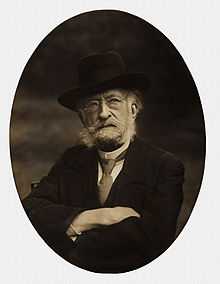Émile Cartailhac

Émile Cartailhac (15 February 1845, Marseille – 26 November 1921, Geneva) was a French prehistorian, one of the founding fathers of the studies of the cave art. He is perhaps best remembered because of his involvement with the Altamira paintings.
He got interested in prehistory (studies of which were then just beginning) at a very young age. He made excavations around the dolmens in Aveyron, and also in Portugal, Iceland and the Balearic Islands. In 1867 he was the supervisor of the prehistory section at a world's fair in Paris. Two years later, he became the chief editor of the revue Matériaux pour l'histoire naturelle et primitive de l'homme founded by Gabriel de Mortillet. This position he held until 1887. From 1882 he taught at the university in Toulouse and in 1897 he was elected a curator of Académie des Jeux floraux. After changing his opinion about Altamira, he became one of the founders of the studies of the cave art and one of the scientists (together with e. g. Henri Breuil) who recognised its importance. With Breuil he made the initial survey of the Caves of Gargas at Aventignan in the Pyrennees, and where Félix Régnault discovered Gravettian cave art in 1906. He was (together with Breuill and Marcellin Boule) one of the founders of Institut de paléontologie humaine in Paris (following a generous donation from Albert I).
Cartailhac and Altamira
When Sautuola's daughter María discovered the paintings in Altamira and Sautuola, together with professor Vilanova, published their findings in 1880, Cartailhac was one of the leaders of the scientists who, suddenly facing a revolutionary change in the view of the prehistoric man, ridiculed these paintings at the 1880 Prehistorical Congress in Lisbon. Due to this opinion, the members of the congress did not even visit Altamira. He changed his mind after several other caves with clearly prehistoric paintings had been found and visited the cave with Breuill in 1902. He apologised there to María de Sautuola (her father died in 1888) and promised her to do everything to clear don Sautuola's name (Sautuola had even been accused of forgery). His letter from 9 October 1902 says among other things: "We live in a new world". He also wrote a famous article, Mea culpa d'un sceptique in which he admitted he was deeply wrong, emphasized the importance of Altamira, accused himself of holding back the progress of his science, and harshly criticised himself for doing an injustice to an honest man and rejecting a thing without any investigation. Today, opinions about this article vary. Kleibl praises it as "one of the finest moments of prehistory" and a "brave article, showing no fear of hurting his" [Cartailhac's] "professional credit",[1] while Lewis-Williams writes about it as about an opportunist thing used calculatingly for Cartailhac's own benefit when his position was no longer tenable.[2]
Works
- Émile Cartailhac, Henri Breuil, Les peintures de la grotte d'Altamira à Santillana (Espagne). Comptes rendus de l'Académie des Inscriptions et Belles-Lettres, p. 256-264, et Compte rendu de l'Académie des Sciences, p. 534. (1903)
- Émile Cartailhac, Les peintures préhistoriques de la caverne d'Altamira. Conférence faite au Musée Guimet. In-18 de 25 p. Paris, Leroux. (1904)
- Émile Cartailhac, Henri Breuil, Les peintures et gravures murales des cavernes pyrénéennes. Altamira et Marsoulas. L'Anthropologie, t. XV, p. 625. Fig. (1905)
- Émile Cartailhac, Henri Breuil, La caverne d'Altamira à Santillana, près de Santander (Espagne). - 1st volume of Peintures et gravures murales des cavernes paléolithiques, published thanks to a grant from Albert I. Grand In-4°, 287 pages, 37 engravings. Monaco, 1906 (paru en 1908).
References and external links
| Wikimedia Commons has media related to Émile Cartailhac. |
- Cave paintings
- "Les peintures préhistoriques de la grotte d’Altamira", Cartailhac and Breuil founding article (1903), online and analyzed on BibNum [click 'à télécharger' for English version]
|